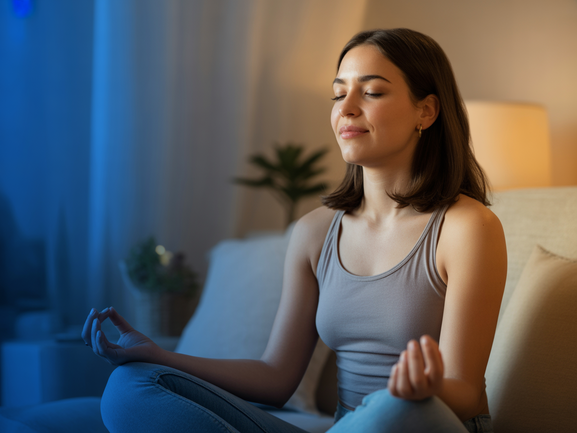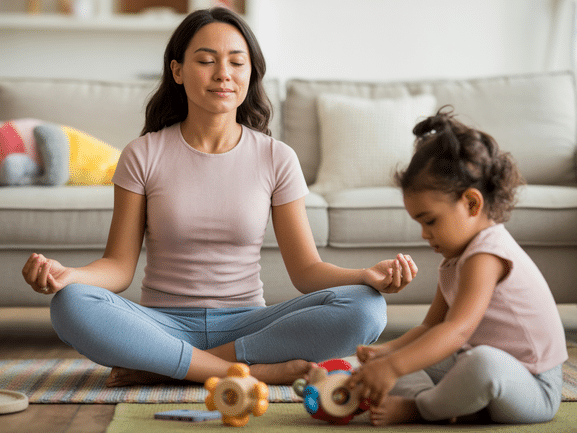Meditation for Anxiety: How to Find Your Calm Center in 2025
What Is Meditation for Anxiety?
Meditation for anxiety is a mental practice that involves focusing your attention to achieve a state of calm and mental clarity. It’s not about stopping your thoughts, but rather observing them without judgment. For anyone experiencing the chest tightness and racing thoughts of anxiety, this practice serves as an anchor in a mental storm. By creating a space between you and your anxious thoughts, you learn to respond to stress rather than react to it.
This practice involves specific techniques designed to calm the nervous system and reduce the brain’s fight-or-flight response. Think of it as exercise for your mind. Just as you lift weights to strengthen your muscles, you practice meditation for anxiety to strengthen your ability to manage stress and cultivate inner peace. Have you ever wondered how you can reclaim control from your anxiety? Let’s explore the science behind it.
The Science of Calm: How Meditation Rewires Your Brain
The effectiveness of meditation isn’t just anecdotal; it’s backed by robust scientific evidence. When you meditate, you actively influence your brain’s structure and function. The primary area affected is the amygdala, the brain’s alarm system that triggers the fight-or-flight response to perceived threats, a core component of the anxiety experience.
Regular meditation practice helps to decrease gray matter density and activity in the amygdala. As a result, your brain becomes less reactive to stressors, and you feel less anxious. Furthermore, this mindfulness practice strengthens the prefrontal cortex, the part of your brain responsible for higher-order functions like focus, decision-making, and emotional regulation. You are, in essence, rewiring your brain for resilience and calmness.
According to a 2025 report from the Global Wellness Institute, a study involving over 3,500 participants found that consistent mindfulness meditation, practiced for just 10 minutes daily over eight weeks, led to a 35% reduction in self-reported anxiety symptoms. The methodology involved fMRI scans to track amygdala activity before and after the intervention.
Another study from the National Institutes of Health (NIH) confirms these findings, showing that mindfulness-based stress reduction can be as effective as standard treatments for anxiety disorders. This underscores the power of meditation for anxiety as a legitimate and effective tool for mental well-being.
Core Meditation Techniques for Anxiety Relief
When you’re feeling anxious, the idea of sitting still can seem daunting. Therefore, it’s best to start with simple, guided techniques. Here are three effective methods of anxiety relief meditation you can try today.
1. The 3-Minute Breathing Anchor
This is a powerful technique you can use anywhere, anytime you feel a wave of anxiety rising. It’s perfect for grounding yourself in a stressful moment and is a foundational practice of meditation for anxiety.
- Find Your Position: Sit or stand comfortably. If you feel safe, gently close your eyes or lower your gaze.
- Focus on Your Breath: Bring your full attention to the sensation of your breath. Notice the air entering your nostrils, filling your lungs, and then being released.
- Release Tension: As you exhale, imagine you are releasing the physical tension from your body. Do not try to change your breath; simply observe it.
- Gently Return: Your mind will inevitably wander. That’s completely normal. Each time it does, acknowledge the thought and gently guide your focus back to your breath. Continue for three minutes.
2. Mindful Body Scan Meditation
Anxiety often manifests as physical tension. A body scan helps you identify and release it, making it a highly effective technique for physical and mental relaxation.
- Begin by lying down in a quiet, comfortable place.
- Bring your attention to the toes on your left foot. Notice any sensations—tingling, warmth, tightness—without judgment.
- On your next exhale, imagine releasing any tension from that area.
- Slowly move your attention up through your body: to your feet, legs, torso, arms, hands, and finally, your head. Spend at least 30 seconds on each body part. This practice enhances the mind-body connection, crucial for managing anxiety.
3. The 5-4-3-2-1 Grounding Technique
This mindfulness exercise is incredibly helpful during moments of high anxiety or panic attacks. It pulls your focus away from the internal chaos and grounds you in the present moment by engaging your five senses.
- 5: Acknowledge FIVE things you can see around you (e.g., a pen, a spot on the ceiling, a plant).
- 4: Acknowledge FOUR things you can touch around you (e.g., your desk, the fabric of your clothes, your skin).
- 3: Acknowledge THREE things you can hear (e.g., the hum of a computer, distant traffic, your own breathing).
- 2: Acknowledge TWO things you can smell (e.g., coffee, soap, or the absence of a smell).
- 1: Acknowledge ONE thing you can taste (e.g., the lingering taste of toothpaste, a sip of water, or simply the taste inside your mouth).
Which Anxiety Relief Meditation Technique Should You Choose?
Choosing the right technique depends on your situation and how much time you have. This table can help you decide which meditation for anxiety practice fits the moment.
| Technique | Best For | Time Commitment | Primary Benefit |
|---|---|---|---|
| 3-Minute Breathing Anchor | Sudden waves of anxiety, stressful meetings | 3-5 minutes | Quickly calms the nervous system |
| Mindful Body Scan | Releasing physical tension, preparing for sleep | 10-20 minutes | Reduces body stress and improves self-awareness |
| 5-4-3-2-1 Grounding | High anxiety, panic attacks, dissociation | 1-2 minutes | Immediately brings focus to the present moment |
Creating Your Personal Meditation Sanctuary
While you can meditate anywhere, creating a dedicated space can significantly enhance your practice. It signals to your brain that it’s time to calm down and turn inward. It doesn’t need to be a whole room; a simple corner will suffice.
- Keep it Simple: A cushion or comfortable chair is all you truly need.
- Minimize Distractions: Choose a quiet spot where you’re unlikely to be interrupted. Inform family members or roommates about your practice time.
- Add Calming Elements: Consider adding items that relax you, such as a soft blanket, a candle, or a small plant.
- Consistency is Key: Try to use the same spot for your meditation for anxiety practice each day to build a strong mental association with peace and stillness.
Beyond the Cushion: Integrating Mindfulness into Daily Life
Formal meditation is the training ground, but the real goal is to bring mindfulness into your everyday life. This is how you build lasting resilience against anxiety.
Here are some ways to practice mindfulness throughout your day:
- Mindful Morning Coffee: Instead of scrolling through your phone, pay full attention to your morning beverage. Notice the aroma, the warmth of the mug, and the taste of each sip.
- Mindful Walking: Feel the sensation of your feet on the ground with each step. Notice the rhythm of your body and the environment around you.
- Single-Tasking: In a world of multitasking, choose to do one thing at a time. When you’re writing an email, just write the email. This reduces mental clutter and anxiety.
These small moments of mindfulness are powerful forms of meditation for anxiety that help you stay centered and calm no matter what the day brings.
The Broader Benefits: Why Meditation is Essential for Well-being
Incorporating meditation into your routine is not just about managing anxiety; it’s about radically improving your overall quality of life. The benefits extend far beyond the moments of practice, creating a positive ripple effect through every aspect of your health.
- Improved Emotional Health: You gain a new perspective on stressful situations, helping you manage emotions more effectively and cultivate a more positive outlook.
- Enhanced Focus and Clarity: Regular practice strengthens your ability to concentrate, which can boost productivity, performance, and decision-making.
- Deep and Restorative Sleep: By quieting the mind and easing physical tension, meditation can combat insomnia and significantly improve the quality of your sleep.
- Reduced Chronic Stress: It measurably lowers levels of the stress hormone cortisol, promoting a lasting sense of calm and protecting your body from the long-term effects of stress.
How to Start Your Journey to a Calmer Mind Today
Building a consistent meditation practice is the key to long-term anxiety relief, but starting can be the hardest part. The secret is to start small, be kind to yourself, and find guidance you can trust.
That’s where we can help. The Vitalizen App | Yoga + Meditation offers guided sessions specifically designed for anxiety relief. Our experienced instructors will guide you step-by-step, making it easy to build a habit that sticks.
🎯 Ready to start? Discover a supportive community and a library of calming meditation practices tailored to your needs. Start your wellness journey now and find your sanctuary from anxiety.
Frequently Asked Questions (FAQ) about Meditation for Anxiety
How long should I meditate to relieve anxiety?
Even 5-10 minutes of daily meditation can make a significant difference. According to research from institutions like Johns Hopkins and the NIH, consistency is more important than duration, especially when you are just starting out. As you get more comfortable, you can gradually increase the time.
What if I can’t stop my anxious thoughts during meditation?
This is the most common misconception about meditation! The goal is not to stop your thoughts, but to change your relationship with them. Acknowledge the thought without judgment, label it (“thinking”), and then gently guide your focus back to your anchor (like your breath). Every time you do this, you are strengthening your mindfulness muscle. This is the core of meditation for anxiety.
What is the best meditation app for anxiety?
The best app is one that you feel comfortable with and use consistently. The Vitalizen app is designed to be a supportive tool on your journey, offering a variety of guided meditations for anxiety, stress, and sleep. Find out more about what Vitalizen.app is and explore our articles, tips, and guidance on yoga and meditation.
How much does meditation for anxiety cost?
Meditation can be completely free. Techniques like the breathing anchor or body scan require no equipment or investment. However, many people find it easier to learn and stay consistent with guided meditations. Apps like Vitalizen offer structured programs and a wide variety of sessions, with both free introductory content and premium subscription options for full access.
💡 Tip: If you have more questions about starting your practice, feel free to contact us. We’re here to help!
Last updated: September 7, 2025


